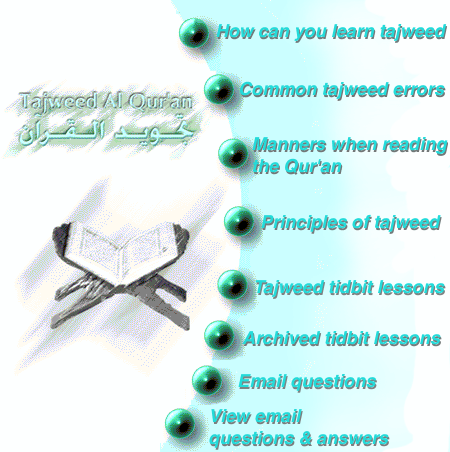|
|

copyright © 2002, abouttajweed.com, all rights reserved |
Question
(15
Sha'baan 1422/ Oct. 31, 2001) We have learned that there are different levels of reading in the reading of the Holy Qur'an; a slow, a medium and a quicker way. Would the reading of Sheikh Abdullah Basfar in his "muallim" (teaching) tapes be an example of the slow way? Then he has a reading taken from his reading in prayer I think which is quicker. Would that be the medium way? If possible could you give examples of the different ways? Question (12 Sha'baan 1422/ Oct. 28, 2001) Your
answer to my question about qalqalah was very helpful and I now have another
question about difficulty in saying the letters
Again
may Allah reward you greatly. Question (11 Sha'baan 1422/ Oct. 27, 2001) Assalamu
alaykum wa rahmatullah Our
study circle has audio recording of Sheikh Muhammad Jibril, which seems to be
the reading of Hafs an Asim but not of the Shaatibi, as per your previous
explanation. Some of us like it, but we do not know for sure all the
lengthening standards of this style. Apparently only the lengthening with an hamzat
al-qat' (with about 4 counts) and the lengthening with a shaddah that
follow a madd letter (with apparently 6 counts are followed). Could you
please explain the major lengthening pattern and other features of this way of
reading? Meanwhile,
other members of our group want to simplify: every place where there is a
sign of madd to be lengthened similarly, with 4 counts on average. Could this
be acceptable and if yes, which way of reading is it among the recognized one?
Wassalamu
alaykum wa rahmatullah Question (10 Sha'baan 1422/ Oct. 26, 2001) Could
you please explain the making of a nice qalqalah? It sometimes sounds
"not sharp" in our tajweed class almost an "imprisoned"
sound unlike on the Holy Qur'an cassettes. May Allah reward you. Question (8 Sha'baan 1422/ Oct. 24, 2001) Assalamualikum
! Question (8 Sha'baan 1422/ Oct. 24, 2001) May
Allah reward you for your clear and informative answers. I have a
question today about a word in surah: Al-A'raaf aayah 196
It is about the 2nd word; could you please explain what are the letters and their sequence - on what letter is the second kasrah? Thank you. Question Assalamu
alaykum wa rahmatullah. Thank you indeed for your help in answering previous
questions. 1)
It seems that the sound "la" in the name "Allah,"
Subhanahu wa Ta'ala, is different from other sounds "la" when
it is preceded by a fathah or dhammah. I heard that is it a way of glorifying
the name of our Lord. But I do not understand why then the same principle is
not applied when the "la" is preceded by a kasrah (a letter having
the vowel i). 2)
The sound "ra"
(letter ra with fathah) is pronounced a little like "ro" while there
is no particular change (apparently) when the letter is voweled with i or u.
What can be the reason? 3)
Why are the sakinah form the
letters jim, dal, ba, etc. (the qalqalah letters?) pronounced heavily, as if
they had a vowel, especially at the end of a word? Question (5 Sha'baan 1422/ Oct. 21, 2001) Assalaamu alaikum. Is there any difference in the letters of tafkheem or all are the same ? Could you give any pointers in doing it right? Jazakumullahu khairan. Question (4 Sha'baan 1422/ Oct. 20, 2001) Assalamu
alaykum wa rahmatullah Jazakum
Allah khayran for your valuable help. I would like some more details: (I
guess the letters laam-alif
Wassalamu alaykum wa rahmatullah Question (3 Sha'baan 1422/ Oct. 19, 2001) A question has come up as to how many letters are in the Arabic alphabet ; some say 28 and others I think say 29 - is that right and if so what is the reason? Question (3 Sha'baan 1422/ Oct. 19, 2001) Hello and good day. Would you be capable of informing me of how the English word, peace, (meaning peace in the context of, "peace on earth"), appears when translated into original Arabic language form, and if there are any variations? I know the word is salaam, but I'm not quite sure how it appears in Arabic. I would greatly appreciate your assistance if possible, but if not then no problem. Thanks so much for your time and have a nice day. :) Question (1 Sha'baan 1422/ Oct. 17, 2001) In reading about the ghunnah and where the sound comes from I was wondering: is there any difference between one ghunnah and another other than the length of the timing? |